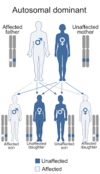DNA Repair & Cancer Flashcards
(18 cards)
What is DNA Replication stress?
DNA replication stress is inefficient replication that leads to replication fork slowing, stalling &/or breakage
Identify 3 causes of DNA replication stress
- Replication machinery defects
- Factors hindering replication fork progression
- Defects in response pathways e.g. helicases
Nucleotide misincorporation is a replication machinery defect.
What causes it?
Defects in 3’ to 5’ exonuclease capacity of DNA polymerases

Repetitive DNA is a replication fork hindrance.
What causes it?
Replication fork slippage:
- Resulting in insertion
- Resulting in deletion

The effects of replication fork slippage can be seen in trinucleotide repeat disorders.
Identify and describe and example of this
Huntington’s disease where triplet repeat expansion leads to neurodegeneration

What is Huntington’s disease?
Huntington’s disease is an inherited neurodegenerative disease, affecting mostly basal ganglia and leading to the degeneration of voluntary motor functions, procedural learning, routines, cognition and emotions

What is significant about the CAG repeats in Huntington’s disease?
- Normal gene: 6–39 repeats
- Disease gene: 35–121 repeats
- Number of repeats is inversely correlated with age of onset

State the pattern of inheritance of Huntington’s disease

Describe the molecular basis for Huntington’s disease
- Mutant protein accumulates and aggregates in neurons
- Mutant protein disrupts various cellular processes & functions, leading to cell dysfunction and death
In Huntington’s disease, death usually occurs 15-20 years after symptoms begin.
Identify 5 symptoms
- Irritability
- Depression
- Small involuntary movements
- Poor coordination
- Difficulties speaking/swallowing
What is the Werner protein?
The Werner protein is a helicase that is important during DNA replication
What is Werner Syndrome?
Werner syndrome is a clinical condition involving mutations in the WRN gene leading to DNA replication defects, DNA damage and ultimately, cell growth defects

State the pattern of inheritance of Werner Syndrome

In Werner Syndrome, patients prematurely display features associated with normal ageing.
Identify 5 other symptoms

- Cataracts
- Skin ulcers
- Type II diabetes
- Atherosclerosis
- Osteoporosis
Identify the two main forms of DNA damage and their resulting effects
- Genomic mutations: Huntington’s disease & cancer
- Cell growth inhibition: ageing
Identify 5 ways in which cells can respond to DNA damage
- Apoptosis
- Senescence
- Cell death
- Cell cycle transitions
- Transcription
Identify 4 exogenous forms of DNA damage
- Ionising radiation
- Anti-cancer agents
- Alkylating agents
- UV light
Identify 2 endogenous forms of DNA damage
- Free radicals
- DNA replication erros


